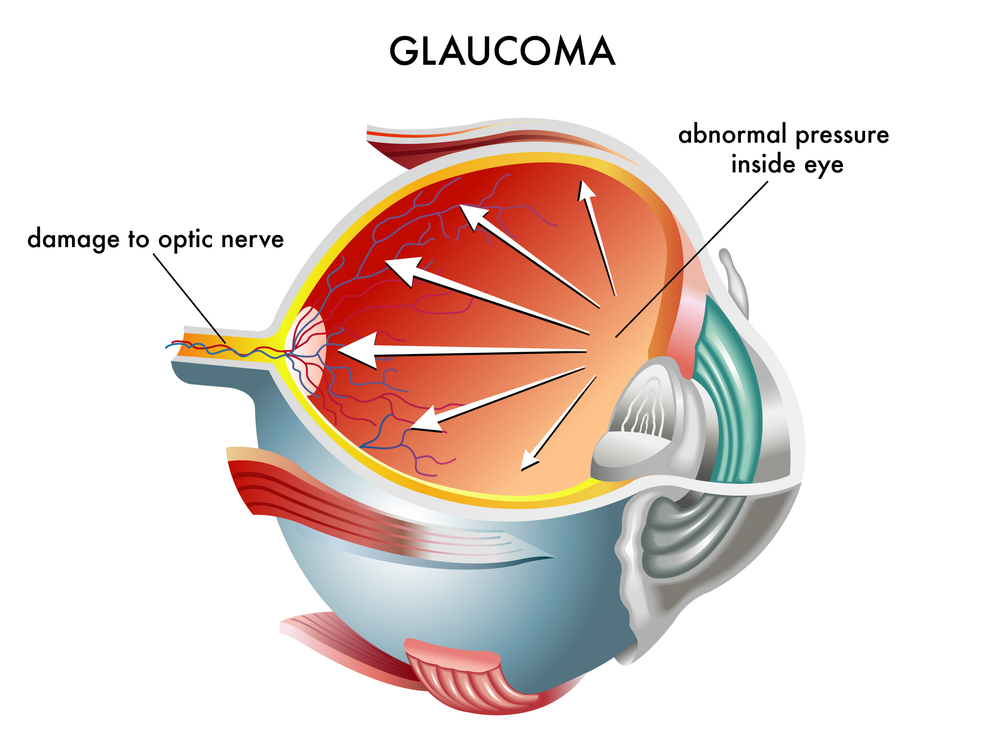Glaucoma
What is Glaucoma?
Glaucoma is an eye disease that slowly and painlessly steals away your sight. Glaucoma is called the silent thief of sight because it has no symptoms—it does not make your eyes red or cause pain. But it is the second leading cause of blindness in the United States, and half of the people who have glaucoma don’t know that they have the disease and are not aware that they are going blind.
The cause of glaucoma is unknown, but there are several risk factors that increase your risk of developing glaucoma. These include high eye pressure (called intraocular pressure, or IOP), older age, being African-American or Hispanic, and having a family history of glaucoma. Anyone with any of these risk factors should get regular eye examinations to look for glaucoma.

Glaucoma damages vision by destroying the optic nerve, which connects your eye to your brain, and carries visual information to your brain for processing. When the optic nerve is damaged from glaucoma, you lose your vision. Your peripheral vision—or side vision—is lost first. If the glaucoma remains untreated, the vision loss creeps in toward the center, first causing tunnel vision, and then, eventually, blindness.
The cause of optic nerve damage in glaucoma is not known, but since most eyes with glaucoma have high IOP, it is likely that high IOP plays a role in damaging the nerve. IOP is a measure of the fluid pressure inside the eye. The eye is filled with clear fluid that flows in through a spigot and flows out through a drain. In glaucoma, the drain of the eye gets plugged, and fluid coming into the eye cannot get out, raising the IOP.
A thorough examination for glaucoma should include the measurement of IOP. But since some eyes can have glaucoma without high IOP, a careful examination of the optic nerve looking for glaucoma damage is also very important. If the IOP is high or the optic nerve looks damaged (or both), a special test called a visual field test should be performed. The visual field test shows whether or not you’ve lost any side vision to glaucoma.
If you are diagnosed with glaucoma, treatment is available to save your vision. The goal of glaucoma treatment is to lower IOP and stop the optic nerve damage. Several kinds of treatment are available to lower IOP. These include eye drops, laser therapy, and surgery.
Eye drop medications lower IOP by either reducing the amount of fluid entering the eye or increasing the amount of fluid exiting the eye. There are several different kinds of glaucoma medications, and each differs in terms of both its ability to lower IOP and its potential side effects. Laser therapy is often used when medications fail to successfully lower IOP, and is also used for patients who cannot tolerate medications due to side effects. Recent advances in laser therapy have produced lasers so safe and effective that for some patients, laser therapy is used instead of medications. If medications and/or laser therapy fail to bring the IOP down to a safe range, surgery is available to lower IOP.
Glaucoma Risk Factors
Everyone is at risk but there are factors that increase the risk.
- Age – People over age 60 are at increased risk for the disease. For African Americans, however, the increase in risk begins after age 40. The risk of developing glaucoma increases slightly with each year of age.
- Race – African Americans are significantly more likely to get glaucoma than are Caucasians, and they are much more likely to suffer permanent vision loss as a result. People of Asian descent are at higher risk of angle-closure glaucoma and those of Japanese descent are more prone to low-tension glaucoma.
- Family history of glaucoma – Having a family history of glaucoma increases the risk of developing glaucoma.
- Medical conditions – Some studies indicate that diabetes may increases the risk of developing glaucoma, as do high blood pressure and heart disease.
- Physical injuries to the eye – Severe trauma, such as being hit in the eye, can result in immediate increased eye pressure and future increases in pressure due to internal damage. Injury can also dislocate the lens, closing the drainage angle, and increasing pressure.
- Other eye-related risk factors – Eye anatomy, namely corneal thickness and optic nerve appearance, indicate risk for development of glaucoma. Conditions such as retinal detachment, eye tumors, and eye inflammations may also induce glaucoma. Some studies suggest that high amounts of nearsightedness may also be a risk factor for the development of glaucoma.
- Corticosteroid use – Using corticosteroids for prolonged periods of time appears to put some people at risk of getting secondary glaucoma.


